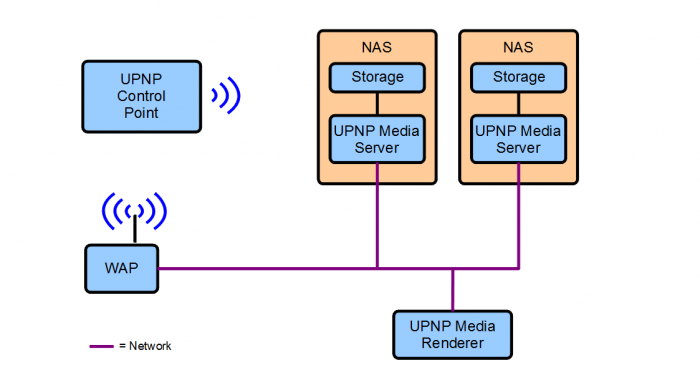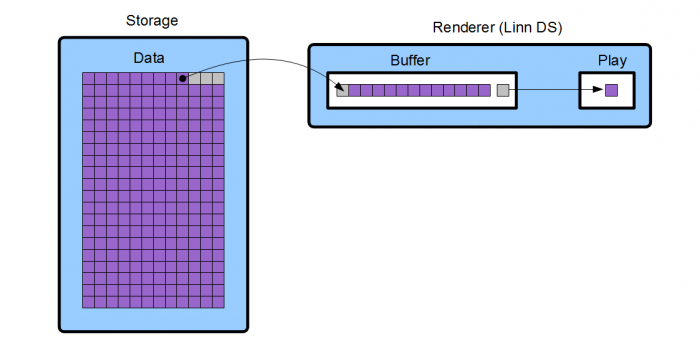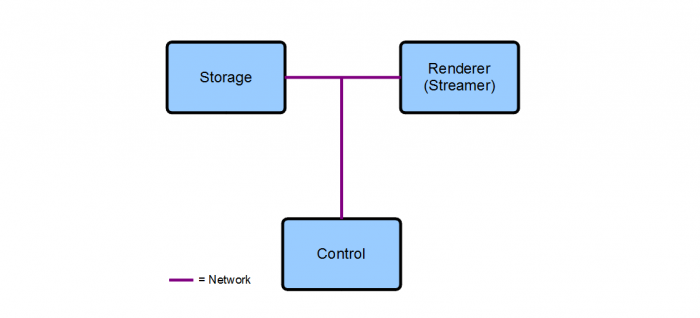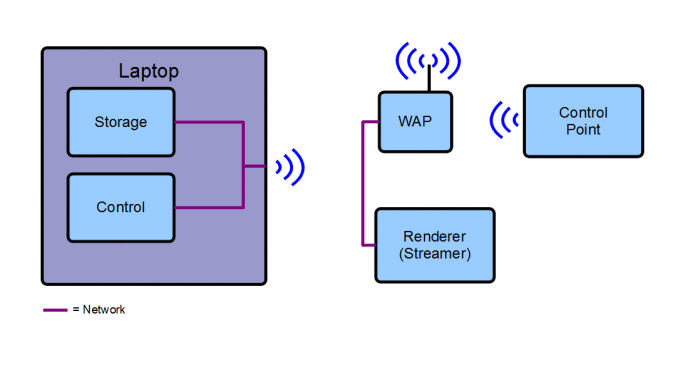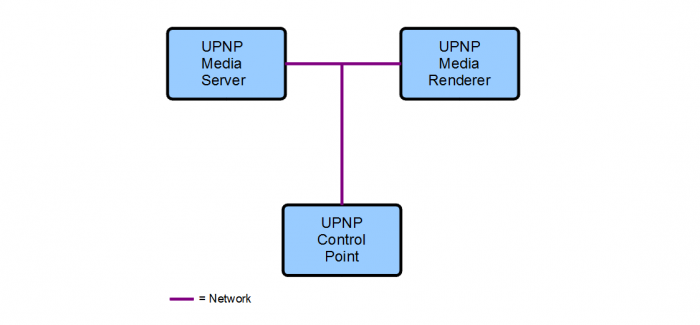Introduction To DS Concepts
Contents
- 1 Introduction
- 2 Streaming
- 3 Network Streaming System
- 4 Basic Streaming Network
- 5 Basic Streaming Network With Wireless Access
- 6 Basic Streaming Network With Wireless Streaming And Control
- 7 Streaming Network With NAS
- 8 Streaming Network With NAS And Wireless Control
- 9 Upnp Network Streaming System
- 10 Basic Upnp Network Streaming System
- 11 Basic Upnp Network Streaming System With Wireless Control
- 12 Upnp Network Streaming System With NAS
- 13 Upnp Network Streaming With NAS and Wireless Control
- 14 Upnp Network Streaming With Multiple NAS Devices
Introduction
The following information introduces the concepts and terminology associated with Linn DS devices and systems. Linn DS devices play, or render, audio which has been retrieved from a location on a network. The network may be a small local network or a larger network such as the internet. The method used to retrieve or transfer the audio is called streaming. DS devices are sometimes referred to as digital streamers, but a more accurate title is media renderer.
Linn DS players rely on the existence of a standard network infrastructure.
Streaming
Streaming is a method of delivering data to a device in a piecemeal manner. Rather than retrieving the whole file, the renderer fetches only a small portion of the file then starts playing immediately. Within the DS is a small reservoir, or buffer, containing the next few pieces of the file, in a queue ready to be played. The buffer is kept topped up, while audio is playing, by retrieving more data from the network. The buffer allows the audio to continue uninterrupted in the event of any brief dropouts in the network delivery. It also allows the audio to be faded out slowly in the event of any long term network interruption.
In the context of media renderers transferring files, there are several advantages to the streaming approach.
- Renderer only requires a small amount of memory
- The size of the file becomes arbitrary
- Small amounts of data can be transferred quickly
These advantages become clearer when one considers the problems associated with the alternative approach of retrieving the whole file before playing. The DS would require enough on board memory to store the largest possible file. In the case of studio master files, this is a lot of memory. In the case of internet radio, the file size is infinite, so it's not possible. When transferring large files, such as studio masters, these could take some time to transfer over the network, resulting in lengthy pauses between songs.
Network Streaming System
The three fundamental components of a network streaming system are storage, control and renderer.
In such a system all of the media (songs, tracks, videos etc) is stored on the storage device. The control device requests the address of a particular item of media from the storage device. It then passes this address to the renderer to play. The renderer then directly retrieves the item from the specified address on the storage device. The renderer then decodes and plays the media as it arrives over the network from storage.
Basic Streaming Network
The most basic streaming network consists of a desktop computer or laptop connected to a renderer via a network. In this system both the storage and control components reside within the computer. The computer's hard drive would represent the storage and an application would provide the control mechanism.
Basic Streaming Network With Wireless Access
A wireless access point (WAP) can be used to give other wireless control devices access to the streaming system.
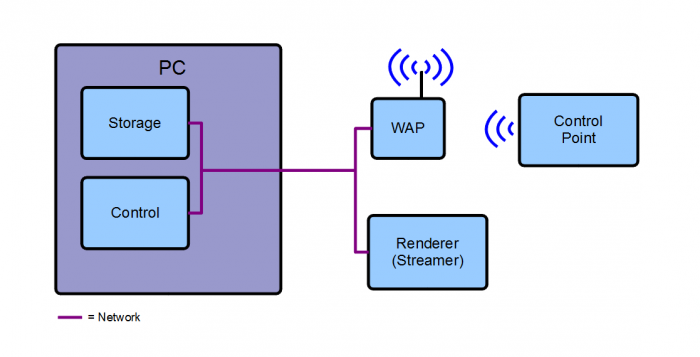
Basic Streaming Network With Wireless Streaming And Control
The computer containing the control and storage components may also be connected to the streaming network via a wireless link. This would allow both the streaming and the control mechanisms to function wirelessly.
This is known as a wireless streaming system because the storage and renderer are wirelessly linked. Although this will frequently work, it is not recommended for use in a high quality audio system, since wireless communications are not reliable enough to guarantee a consistent audio stream and thus could result in interruption to the audio during playback.
Streaming Network With NAS
A NAS (network attached storage) may be used to provide storage to a network streaming system. A NAS consists of a bank of one or more hard disk drives and built in computer in a box that connects directly to the network. The embeddded computer manages and controls access to the drives from other devices on the network.
Streaming Network With NAS And Wireless Control
A wireless access point (WAP) can be used to give other wireless control devices access to the NAS and the renderer.
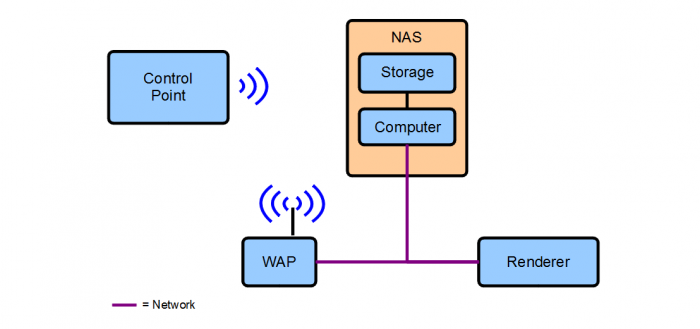
Upnp Network Streaming System
UPnP (Universal Plug and Play) is a set of protocols designed to allow consumer devices to interact over a network. Linn DS devices comply with the UPnP AV protocol, enabling them to communicate with other non-Linn devices, provided they also comply with this protocol.
The role of the three network streaming components can be performed by three standard UPnP components; UPnP Control Point, UPnP Media Renderer and UPnP Media Server. In this system, the Media Server performs the role of the storage mechanism. It doesn't provide the storage but manages access to it by responding to UPnP compatible network requests.
The media server is a software application which scans a specified storage device and builds a database of the media it finds. This database is known as the media library. The media server can be configured in different ways to sort and present the media library in various formats or views ("Album", "Artist", "Genre" etc). This in turn allows UPnP control points to browse and present the media to the user in different ways.
Basic Upnp Network Streaming System
The most basic UPnP network streaming system consists of a desktop computer or laptop connected to a renderer via a network. In this system the storage, control point and media server components reside within the computer. The computer's hard drive is used as storage and software applications provide the control point and media server functionality.
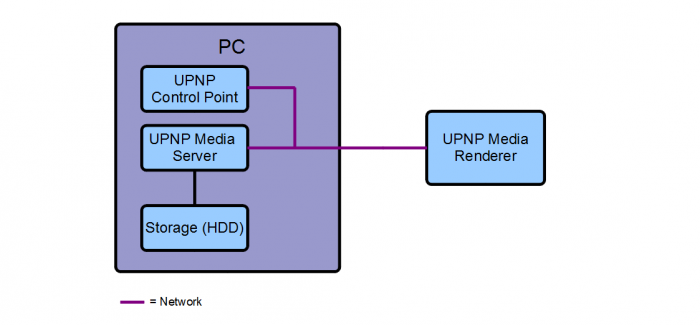
Basic Upnp Network Streaming System With Wireless Control
A wireless access point (WAP) can be used to give wireless UPnP control points access to the UPnP media server and UPnP media renderer.
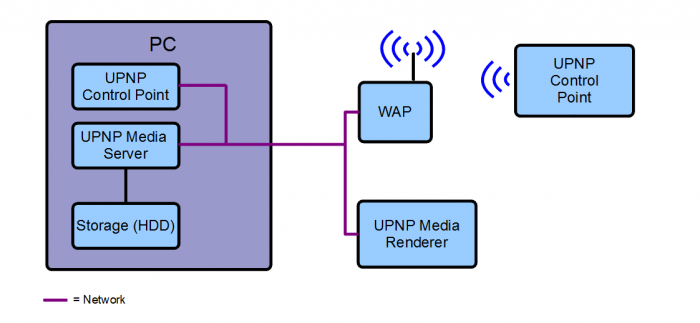
Upnp Network Streaming System With NAS
A NAS (network attached storage) may be used to house the storage and media server in a UPnP network streaming system.
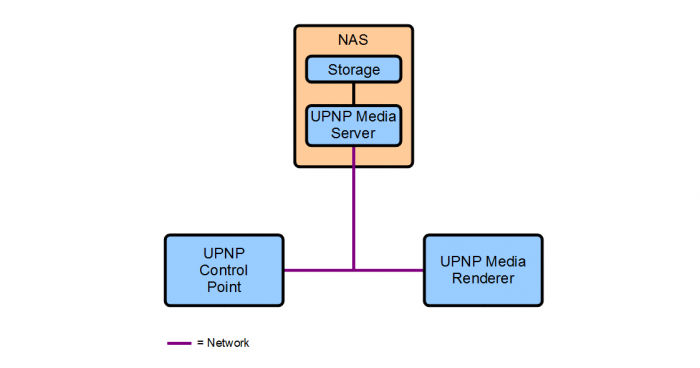
Upnp Network Streaming With NAS and Wireless Control
A wireless access point (WAP) can be used to give other wireless control devices access to the media server and the renderer.
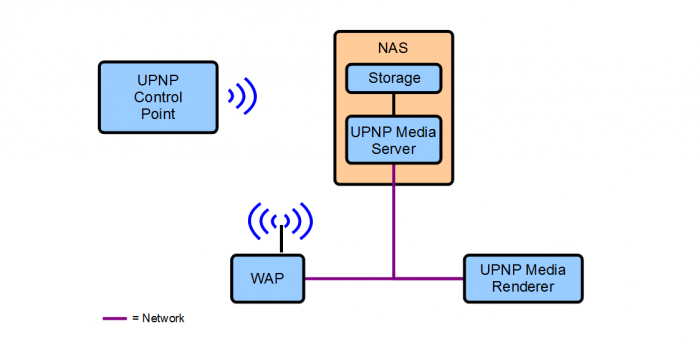
Upnp Network Streaming With Multiple NAS Devices
The UPnP network streaming system can support the use of multiple NAS devices including multiple media servers.
